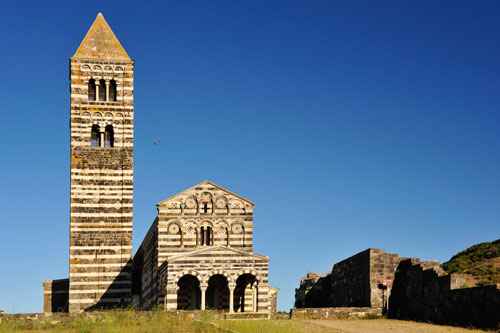Churches in the Surrounding Area of Sassari
map with the marked churches
Santissima Trinità di Saccargia

In Sardinia, there are still a few Pisan country churches, the most beautiful of which is the Santissima Trinità di Saccargia.
The church was built between 1112 and 1116 by Pisan master builders.
They alternated stones of light limestone and dark volcanic rock, creating the striped pattern.
According to legend, the construction was commissioned by the then Judge of Porto Torres and his wife to fulfill a vow.
Originally, there was a monastery of Camaldolese Benedictine monks next to the church. Only a few remnants of the monastery walls remain today.
 The interior of the church is relatively simple.
The interior of the church is relatively simple.
Particularly valuable are the preserved frescoes in the central apse from the 12th century.
At the very top, Christ is enthroned. Surrounded by angels, he holds the Holy Scriptures in his hand.
Below, the twelve apostles are depicted, and at the very bottom, scenes from the Passion and the Harrowing of Hell are illustrated. This Harrowing of Hell is typical of Byzantine art and is depicted instead of the usual Ascension.
 When you stand in front of the church, take a look at the capitals of the columns.
When you stand in front of the church, take a look at the capitals of the columns.
These are very detailed and largely depict fantastic mythical creatures.
On one column, cows can be seen.
The name “Saccargia” likely derives from “s’acca argia” (the speckled cow). According to legend, a cow knelt here to pray.
San Michele di Salvenero

If you follow the SS 597 about 3 km to the east, you will come to a somewhat confusing intersection.
In the immediate vicinity, there are two other examples of typical Pisan country churches.
The first one that catches your eye is the Church of San Michele di Salvenero, located on the right side of the road in a completely overgrown area.
Like the Santissima Trinità di Saccargia, it also has a slight striped pattern on its façade and was built between 1110 and 1130.
The church is usually closed. To at least view it up close, you need to turn right onto a narrow dirt road just before the large intersection when coming from Sassari (see map).
I do not recommend walking along the guardrails at this busy intersection.
Sant’Antonio di Salvenero

This church stands on a small hill next to the power plant (see map).
Sant’Antonio di Salvenero was built between 1220 and 1225 and has been repeatedly altered with additional constructions.
The striped pattern of light limestone and reddish trachyte, which adorns the central part of the church, is clearly visible.
This church is also usually closed.
Next to the church, there is a menhir from prehistoric times, into which a cross was later carved.
San Pietro di Sorres

A little further south, near Borutta, this church stands prominently on a hill (see map).
The original structure dates back to the 10th century and was uniformly built from limestone.
In the 12th century, another story was added, to which the Pisan master builders gave the typical striped pattern.
The church is part of a Benedictine monastery complex, which began the restoration of the church and monastery in the 1950s.
From the parking lot, you have a magnificent view of the surrounding hilly landscape of Logudoro.
 The interior impresses with its striped columns and arches.
The interior impresses with its striped columns and arches.
Notable pieces include the Gothic pulpit from the 13th century and the frescoes in the cloister, depicting scenes from the life of Saint Benedict.
